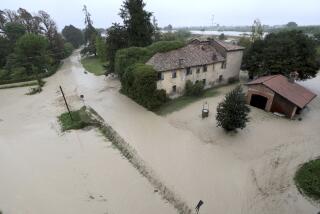Hunt Ends for Pair From F-111 Believed Hit
The Navy called off its search Wednesday for the two missing fliers of an Air Force F-111 fighter-bomber that went down during Tuesday’s bombing raid over Tripoli and a Pentagon source said he was told that the plane “got hit, dropped the ordnance and blew up.”
Adm. William J. Crowe Jr., chairman of the Joint Chiefs of Staff, acknowledged that while the plane’s loss could have been the result of an accident, the possibility that it was hit by Libyan defenses “is a very definite one.”
“I am confident that the crew of the plane was lost,” Crowe said.
Struck Over Target
Another official, who asked not to be identified, said the plane apparently was struck as it flew over its target.
The official said an aerial monitoring system picked up a voice, believed to have been from the plane, saying “We’re hit” after radar-guided anti-aircraft guns threw out “a helluva lot” of fire.
He said one of the F-111’s bombs apparently “went astray” as the plane emerged from a turn, although it was unclear whether the weapon broke loose before or after the plane was struck. He acknowledged that the bomb may have been responsible for damage to the French embassy and other non-targeted buildings in Tripoli.
President Reagan spoke by telephone Wednesday with the wives of the fliers and expressed his “regret and sorrow,” White House spokesman Larry Speakes said. The spokesman said Reagan pledged that he would “try to discover what happened.”
The call was placed to Diana Lorence, wife of Capt. Paul F. Lorence, 31, of San Francisco, and Blanca Ribas, wife of Capt. Fernando Ribas-Dominicci, 33, of Mayaguez, Puerto Rico. Both women are in Britain, where their husbands were stationed.
Terror Command Post
Pentagon officials, assessing the damage of the raid, said that bombs dropped from Air Force F-111s on the Aziziya Barracks in southern Tripoli landed on target in a courtyard. The barracks have been described as a terrorism command-and-control headquarters. Libyan leader Moammar Kadafi, whose 15-month-old daughter was reported to have been killed in the raid, frequently lives there.
The officials added that Navy A-6 attack aircraft scored direct hits on Libyan airplanes on the ground at the Baninah air base in Benghazi. In all, 18 F-111s and 15 A-6’s participated in the mission, although sources said two F-111s and one A-6 were forced to turn back before reaching their targets as a result of mechanical difficulties.
Another Pentagon official said that several F-111s were off course when they arrived at Tripoli after flying 3,200 miles from bases north of London. Holding to rules set before they departed seven hours earlier, they flew over the Mediterranean Sea and dropped their bombs, rather than letting them fall on non-targets in the Libyan capital, he said.
According to an account offered by one Pentagon source, most of the A-6 attack planes dropped 12 bombs, some weighing 500 pounds and some weighing 750, while a number of the F-111s carried four 2,000-pound bombs each. The source said that the warplanes carried nearly maximum loads, and even if some of the F-111 bombs were jettisoned, as much as 100,000 pounds of bombs were dropped on the three targets in Tripoli and two in Benghazi.
‘Reasonable Damage’
“We think we did a reasonable amount of damage to the military targets,” Crowe said on NBC television’s “Today” program. “Obviously, to Kadafi’s headquarters there was quite a bit of damage.”
Later, Speakes said:
“There is no doubt that Libya still has a terrorist capability, however impaired it may be. We have seen no change in their goals of . . . targeting Americans worldwide and they do have that capability. It does not take a lot of explosives for a lone Libyan somewhere in the world to cause problems. But there is a command and control operation. There is a training operation. And it is our goal to cripple that.”
One official denied a report, based on an account of a briefing given to a British member of Parliament, that Libyan surface-to-air missile fire drove off the attacking U.S. planes early Tuesday.
Missiles Posed No Threat
“It was not because of the SAM threat,” said this official, who asked not to be identified. He added that the Soviet-supplied missiles were not considered a threat to airplanes flying at more than 600 m.p.h. at altitudes as low as 200 feet. The weapons are considered most threatening to high-altitude, relatively slow aircraft.
Meanwhile, a Navy source took issue with the Defense Department’s assertion that the Air Force fighter-bombers were brought into the plan out of military necessity. He asserted that the two carriers offered more than enough air power, including more than 70 airplanes with bombing capacities--more than twice the number employed in the raids.
“It was obviously a political decision,” he said, supporting speculation that the F-111s were used for two purposes: to reduce interservice rivalries by giving the Air Force a piece of the operation and to force a British commitment by using airplanes based in Britain.
A senior Pentagon official denied that such thinking went into the decision. He said that military planners decided several months ago, when preparation for such raids was begun, that the British-based bombers would be used if only two aircraft carriers were available.
And Secretary of State George P. Shultz, citing the precision, night-flying equipment and heavy bomb capacity of the F-111s, said in an interview with European reporters that the Air Force jets were “militarily important.”
The long flight from Britain was considered a strain, both on the airmen and the airplanes.
Long Flight a Strain
Describing the weariness that sets in while a pilot and weapons systems officer are strapped to their seats in the crowded cockpit, one former F-111 pilot said: “Your legs get cramped. It’s just like sitting in a car for 14 hours. You lose the sense of feeling in your posterior.”
Using guidance systems that can automatically direct the airplane to within feet of predetermined aerial checkpoints, the crew began intense operations as they approach their targets.
Guidance systems store images of the targets, taken by infrared aerial reconnaissance photography before a mission is launched and these images are compared by the fliers as they near their targets.
Ten miles from the target--about one minute away--an infrared, or heat-seeking, guidance system helps designate a target with a laser beam. With the target in sight on radar scopes, “the pilot depresses the pickle button” on the airplane’s “joy stick,” releasing the bomb, which is guided by the beam to the ground, said the former pilot, speaking on the condition of anonymity.
Times staff writer Maura Dolan contributed to this story.
More to Read
Sign up for Essential California
The most important California stories and recommendations in your inbox every morning.
You may occasionally receive promotional content from the Los Angeles Times.










